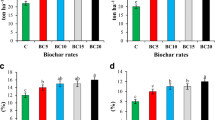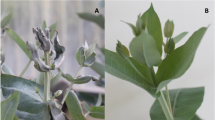Abstract
Purpose
Biochar has been suggested as a soil conditioner to improve soil fertility and crop productivity while simultaneously mitigate global climate change by storing carbon in the soil. This study investigated the effect of pine (Pinus radiata) biochar application on soil water availability, nitrogen (N) and carbon (C) pools and growth of C3 and C4 plants.
Materials and methods
In a glasshouse pot trial, a pine biochar (untreated) and nutrient-enriched pine biochar were applied to a market garden soil with C3 (Spinacia oleracea L.) and C4 (Amaranthus paniculatus L.) plants at rates of 0, 1.0, 2.0, and 4.0 % (w/w). Plant biomass, soil pH, moisture content, water holding capacity (WHC), hot water extractable organic C (HWEOC), and total N (HWETN), total C and N, and their isotope compositions (δ 13C and δ 15N) of soils and plants were measured at the end of the experimentation.
Results and discussion
The soil moisture content increased while plant biomass decreased with increasing untreated biochar application rates. The addition of nutrient-enriched biochar significantly improved plant biomass in comparison to the untreated biochar addition at most application rates. Biochar application also increased the levels of labile organic C and N pools as indicated by HWEOC and HWETN.
Conclusions
The results suggested that the addition of pine biochar significantly improved soil water availability but not plant growth. The application of nutrient-enriched pine biochar demonstrated that the growth of C3 and C4 plants was governed by biochar nutrient availability rather than its water holding capacity under the pot trial condition.



Similar content being viewed by others
References
Anderson CR, Condron LM, Clough TJ, Fiers M, Stewart A, Hill RA, Sherlock RR (2011) Biochar induced soil microbial community change: implications for biogeochemical cycling of carbon, nitrogen and phosphorus. Pedobiologia 54:309–320
Atkinson C, Fitzgerald J, Hipps N (2010) Potential mechanisms for achieving agricultural benefits from biochar application to temperate soils: a review. Plant Soil 337:1–18
Baronti S, Vaccari FP, Miglietta F, Calzolari C, Lugato E, Orlandini S, Pini R, Zulian C, Genesio L (2014) Impact of biochar application on plant water relations in Vitis vinifera (L.). Europ J Agron 53:38–44
Basso AS, Miguez FE, Laird DA, Horton R, Westgate M (2013) Assessing potential of biochar for increasing water-holding capacity of sandy soils. Glob Change Biol Bioenergy 5:132–143
Chan KY, Xu ZH (2009) Biochar: nutrient properties and their enhancement. In: Lehmann J, Joseph S (eds) Biochar for environmental management, science and technology. Earthscan, London
Chen CR, Xu ZH (2005) Soil carbon and nitrogen pools and microbial properties in a 6-year-old slash pine plantation of subtropical Australia: impacts of harvest residue management. For Ecol Manage 206:237–247
Chen CR, Xu ZH, Mathers NJ (2004) Soil carbon pools in adjacent natural and plantation forests of subtropical Australia. Soil Sci Soc Am J 68:282–291
Cheng C-H, Lehmann J, Thies JE, Burton SD (2008) Stability of black carbon in soils across a climatic gradient. J Geophys Res 113:G02027
Clough TJ, Condron LM (2010) Biochar and the nitrogen cycle: introduction. J Environ Qual 39:1218–1223
de Melo Carvalho MT, de Holanda Nunes Maia A, Madari BE, Bastiaans L, van Oort PAJ, Heinemann AB, Soler da Silva MA, Petter FA, Marimon BH Jr, Meinke H (2014) Biochar increases plant-available water in a sandy loam soil under an aerobic rice crop system. Solid Earth 5:939–952
Deenik JL, McClellan T, Uehara G, Antal MJ, Campbell S (2010) Charcoal volatile matter content influences plant growth and soil nitrogen transformations. Soil Sci Soc Am J 74:1259–1270
Güereña D, Lehmann J, Hanley K, Enders A, Hyland C, Riha S (2013) Nitrogen dynamics following field application of biochar in a temperate North American maize-based production system. Plant Soil 365:239–254
Gaskin JW, Speir RA, Harris K, Das KC, Lee RD, Morris LA, Fisher DS (2010) Effect of peanut hull and pine chip biochar on soil nutrients, corn nutrient status, and yield. Agron J 102:623–633
Ghani A, Dexter M, Perrott KW (2003) Hot-water extractable carbon in soils: a sensitive measurement for determining impacts of fertilisation, grazing and cultivation. Soil Biol Biochem 35:1231–1243
Glaser B, Lehmann J, Zech W (2002) Ameliorating physical and chemical properties of highly weathered soils in the tropics with charcoal—a review. Biol Fertil Soils 35:219–130
Hale SE, Lehmann J, Rutherford D, Zimmerman AR, Bachmann RT, Shitumbanuma V, O’Toole A, Sundqvist KL, Arp HPH, Cornelissen G (2012) Quantifying the total and bioavailable polycyclic aromatic hydrocarbons and dioxins in biochars. Environ Sci Technol 46:2830–2838
Ibell P, Xu ZH, Blumfield TJ (2010) Effects of weed control and fertilization on soil carbon and nutrient pools in an exotic pine plantation of subtropical Australia. J Soils Sediments 10:1027–1038
Ibell P, Xu ZH, Blumfield TJ (2013a) The influence of weed control on foliar δ15N, δ13C and tree growth in an 8-year-old exotic pine plantation of subtropical Australia. Plant Soil 369:199–217
Ibell PT, Xu ZH, Blake T, Blumfield TJ (2013b) Effects of weed control and fertilisation at early establishment on tree nitrogen and water use in an exotic F1 hybrid pine plantation of subtropical Australia. J Soils Sediments 13:1538–1552
Jeffery S, Verheijen FGA, van der Velde M, Bastos AC (2011) A quantitative review of the effects of biochar application to soils on crop productivity using meta-analysis. Agric Ecosyst Environ 144:175–187
Jiang YM, Chen CR, Xu ZH, Liu YQ (2010) Soil soluble organic carbon and nitrogen pools under mono- and mixed-species forest ecosystems in subtropical China. J Soils Sediments 10:1071–1081
Kammann C, Linsel S, Gößling J, Koyro H-W (2011) Influence of biochar on drought tolerance of Chenopodium quinoa Willd and on soil-plant relations. Plant Soil 345:195–210
Laird D, Fleming P, Wang B, Horton R, Karlen D (2010) Biochar impact on nutrient leaching from a Midwestern agricultural soil. Geoderma 158:436–442
Lehmann J, Joseph S (2009) Biochar for environmental management: an introduction. In: Lehmann J, Joseph S (eds) Biochar for environmental management, science and technology. Earthscan, London
Lentz RD, Ippolito JA (2012) Biochar and manure affect calcareous soil and corn silage nutrient concentrations and uptake. J Environ Qual 41:1033–1043
Liang B, Lehmann J, Solomon D, Kinyangi J, Grossman J, O'Neill B, Skjemstad JO, Thies J, Luizão FJ, Petersen J, Neves EG (2006) Black carbon increases cation exchange capacity in soils. Soil Sci Soc Am J 70:1719–1730
Major J, Rondon M, Molina D, Riha S, Lehmann J (2010) Maize yield and nutrition during 4 years after biochar application to a Colombian savanna oxisol. Plant Soil 333:117–128
Morison JI, Gifford RM (1983) Stomatal sensitivity to carbon dioxide and humidity: a comparison of two C3 and two C4 grass species. Plant Physiol 71:789–796
Novak JM, Busscher WJ, Watts DW, Amonette JE, Ippolito JI, Lima IM, Gaskin J, Das KC, Steiner C, Ahmedna M, Rehrah D, Schomberg H (2012) Biochars impact on soil moisture storage in an Ultisol and two Aridisols. Soil Sci 177:310–320
Novak JM, Lima I, Xing B, Gaskin JW, Steiner C, Das KC, Ahmedna M, Rehrah D, Watts DW, Busscher WJ (2009) Characterization of designer biochar produced at different temperatures and their effects on a loamy sand. Ann Environ Sci 3:195–206
Rajkovich S, Enders A, Hanley K, Hyland C, Zimmerman A, Lehmann J (2012) Corn growth and nitrogen nutrition after additions of biochars with varying properties to a temperate soil. Biol Fertil Soils 48:271–284
Rawson HM, Begg JE, Woodward RG (1977) The effect of atmospheric humidity on photosynthesis, transpiration and water use efficiency of leaves of several plant species. Planta 134:5–10
Reverchon F, Flicker RC, Yang H, Yan GJ, Xu ZH, Chen CR, Hosseini Bai S, Zhang DK (2014) Changes in δ 15N in a soil-plant system under different biochar feedstocks and application rates. Biol Fertil Soils 50:275–283
Reverchon F, Yang H, Ho TY, Yan GJ, Wang J, Xu ZH, Chen CR, Zhang DK (2015) A preliminary assessment of the potential of using an acacia-biochar system for spent mine site rehabilitation. Environ Sci Pollut Res 22:2138–2144
Rogovska N, Laird D, Cruse R, Fleming P, Parkin T, Meek D (2011) Impact of biochar on manure carbon stabilization and greenhouse gas emissions. Soil Sci Soc Am J 75:871–879
Sparling G, Vojvodic-Vukovic M, Schipper LA (1998) Hot-water-soluble C as a simple measure of labile soil organic matter: the relationship with microbial biomass C. Soil Biol Biochem 30:1469–1472
Steiner C, Teixeira WG, Lehmann J, Nehls T, de Macedo JLV, Blum WEH, Zech W (2007) Long term effects of manure, charcoal and mineral fertilization on crop production and fertility on a highly weathered Central Amazonian upland soil. Plant Soil 291:275–290
Taghizadeh-Toosi A, Clough T, Sherlock R, Condron L (2012) Biochar adsorbed ammonia is bioavailable. Plant Soil 350:57–69
Tutua SS, Xu ZH, Blumfield TJ (2014) Foliar and litter needle carbon and oxygen isotope compositions relate to tree growth of an exotic pine plantation under different residue management regimes in subtropical Australia. Plant Soil 375:189–204
van Zwieten L, Kimber S, Morris S, Chan KY, Downie A, Rust J, Joseph S, Cowie A (2010) Effects of biochar from slow pyrolysis of paper mill waste on agronomic performance and soil fertility. Plant Soil 327:235–246
Woolf D, Amonette JE, Street-Perrott FA, Lehmann J, Joseph S (2010) Sustainable biochar to mitigate global climate change. Nat Commun 1:56
Xu CY, Hosseini-Bai S, Hao YB, Rachaputi RN, Wang HL, Xu ZH, Wallace H (2015) Effect of biochar amendment on yield and photosynthesis of peanut on two types of soils. Environ Sci Pollut Res 22:6112–6125
Xu ZH, Prasolova N, Lundkvist K, Beadle C, Leaman T (2003) Genetic variation in branchlet carbon and nitrogen isotope composition and nutrient concentration of 11-year-old hoop pine families in relation to tree growth in subtropical Australia. For Ecol Manage 186:359–371
Xu ZH, Saffigna PG, Farquhar GD, Simpson JA, Haines RJ, Walker S, Osborne DO, Guinto D (2000) Carbon isotope discrimination and oxygen isotope composition in clones of the F1 hybrid between slash pine and Caribbean pine in relation to tree growth, water-use efficiency and foliar nutrient concentration. Tree Physiol 20:1209–1217
Zhang A, Liu Y, Pan G, Hussain Q, Li L, Zheng J, Zhang X (2012) Effect of biochar amendment on maize yield and greenhouse gas emissions from a soil organic carbon poor calcareous loamy soil from Central China Plain. Plant Soil 351:263–275
Zhao X, Wang J, Wang S, Xing G (2014) Successive straw biochar application as a strategy to sequester carbon and improve fertility: a pot experiment with two rice/wheat rotations in paddy soil. Plant Soil 378:279–294
Acknowledgments
This research was funded by the Australian Research Council under the ARC Linkage Project Scheme (ARC Linkage Project LP100200135), with BHP Billiton Iron Ore Pty Ltd, ANSAC Pty Ltd and ENN as the partner organizations. The authors are grateful to Dr Kai Zeng, Jianbo Wang, Geoffrey Lambert, Rene Diocares, and Carolyn Polson for their technical assistance. We also thank Dr Chengyuan Xu for his valuable comments on this manuscript. Yuzhe Wang also acknowledges Professor Qixing Zhou as his PhD supervisor at his home institution, Nankai University and the scholarship provided by the China Scholarship Council (CSC) to visit Australia as a visiting PhD student.
Author information
Authors and Affiliations
Corresponding author
Additional information
Responsible editor: Jianming Xu
Electronic supplementary material
Below is the link to the electronic supplementary material.
ESM 1
(DOCX 391 kb)
Rights and permissions
About this article
Cite this article
Wang, Y., Zhang, L., Yang, H. et al. Biochar nutrient availability rather than its water holding capacity governs the growth of both C3 and C4 plants. J Soils Sediments 16, 801–810 (2016). https://doi.org/10.1007/s11368-016-1357-x
Received:
Accepted:
Published:
Issue Date:
DOI: https://doi.org/10.1007/s11368-016-1357-x




